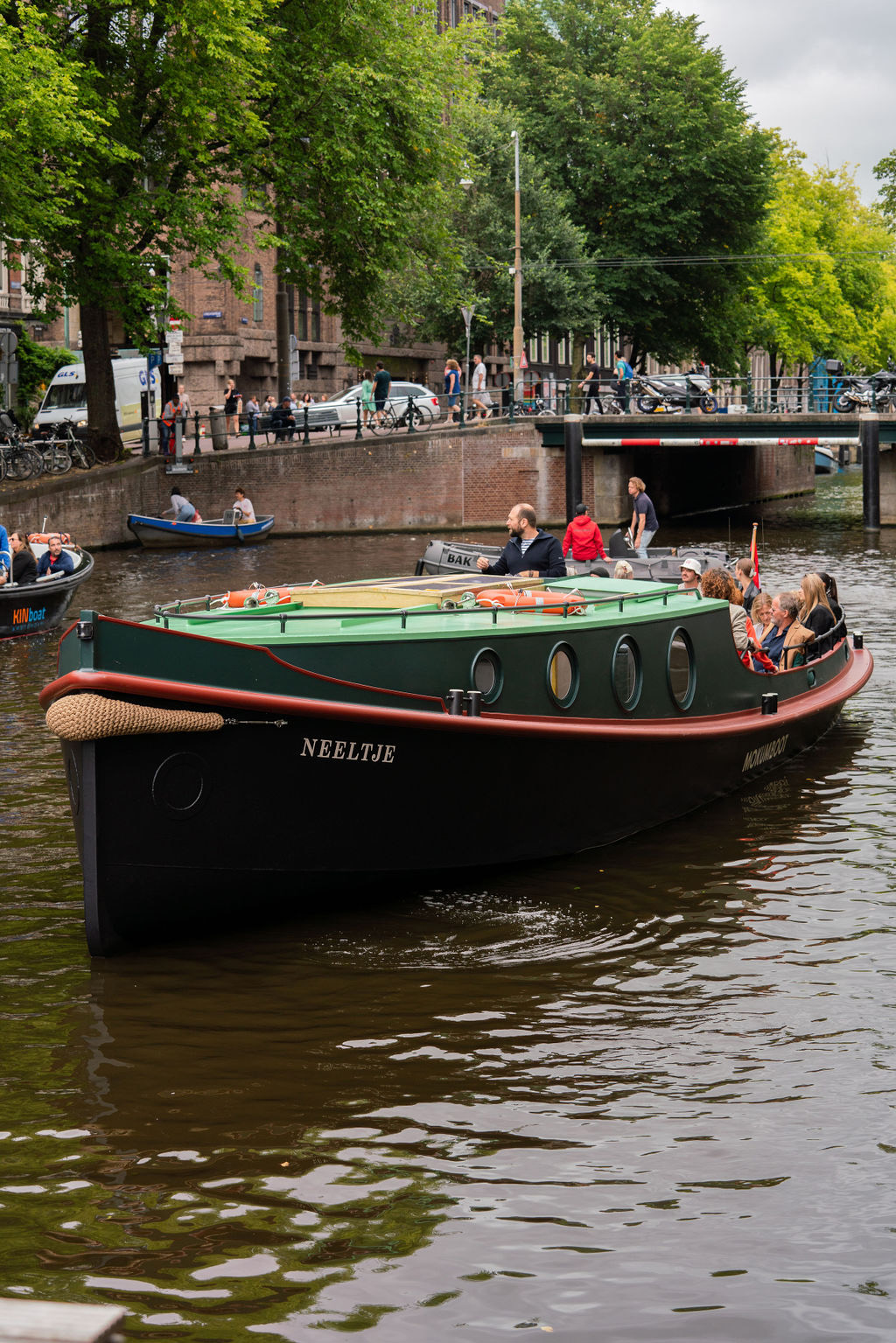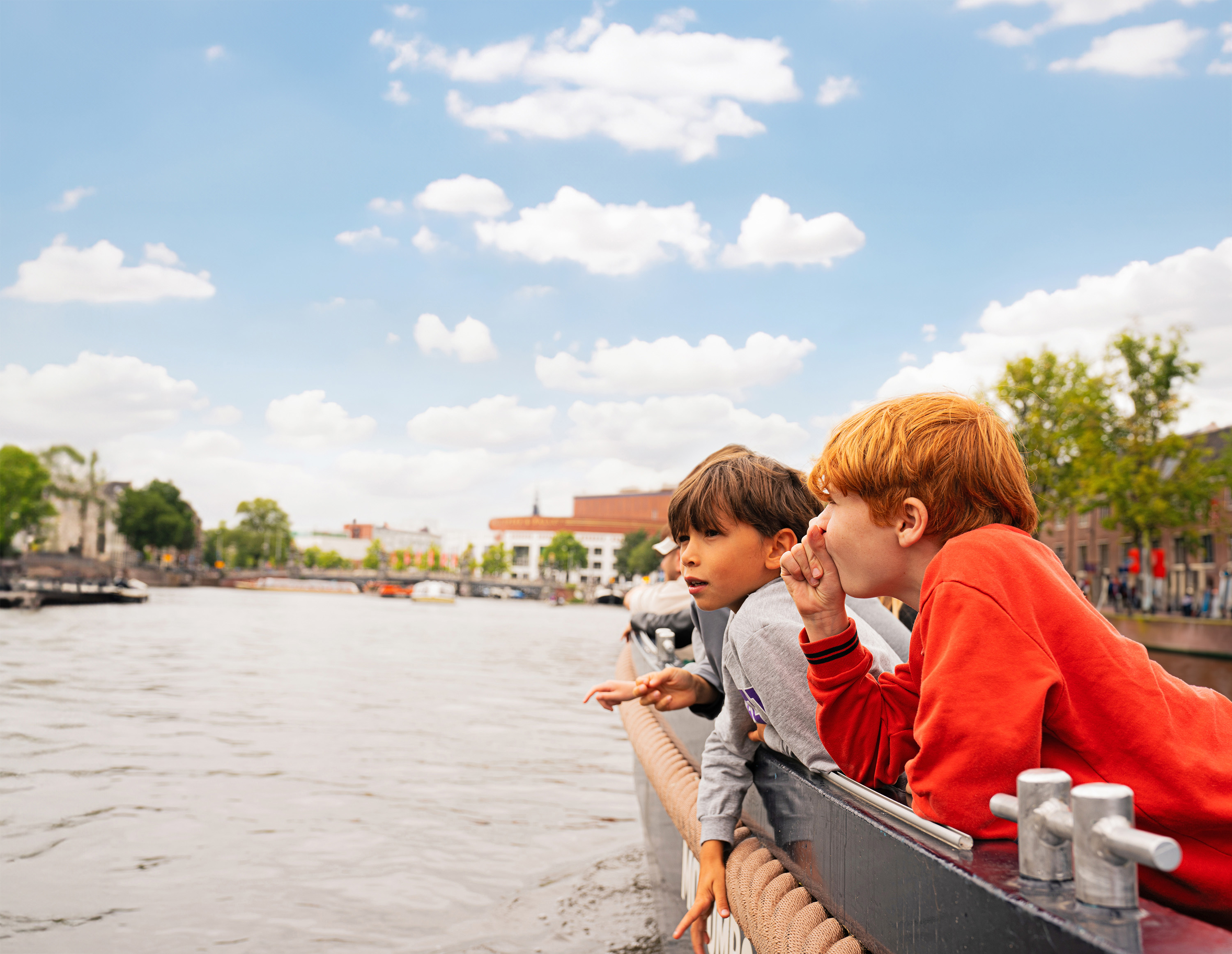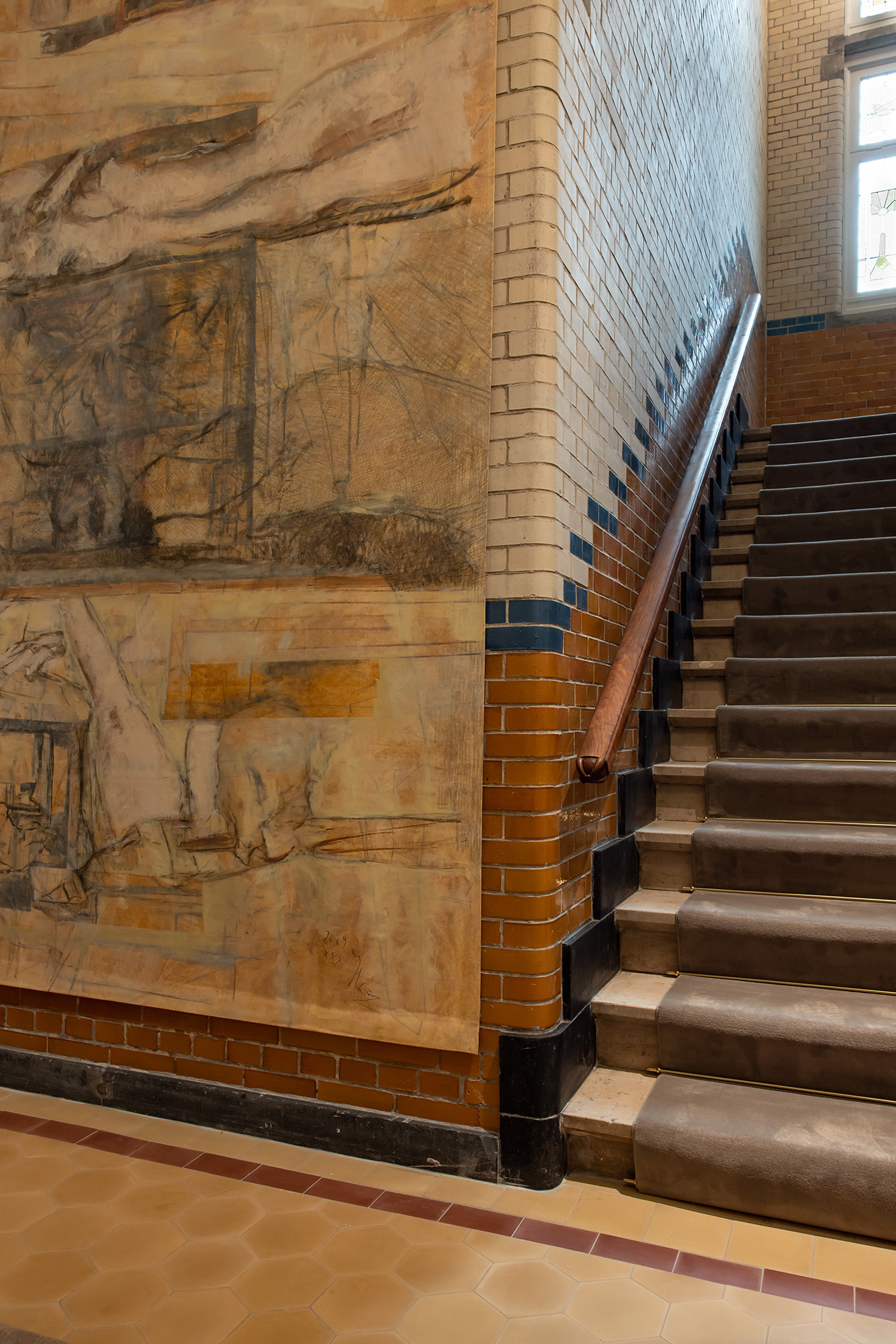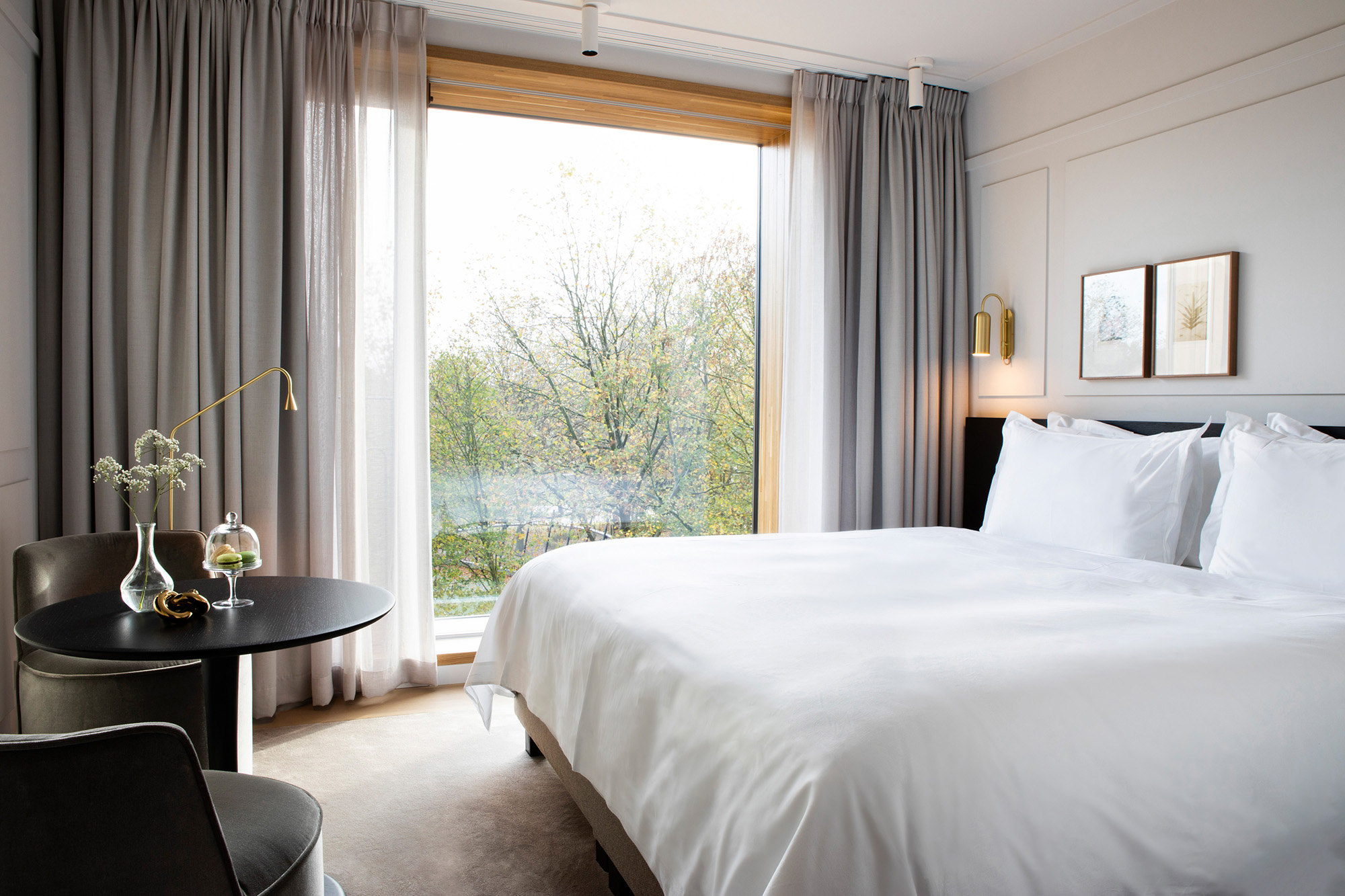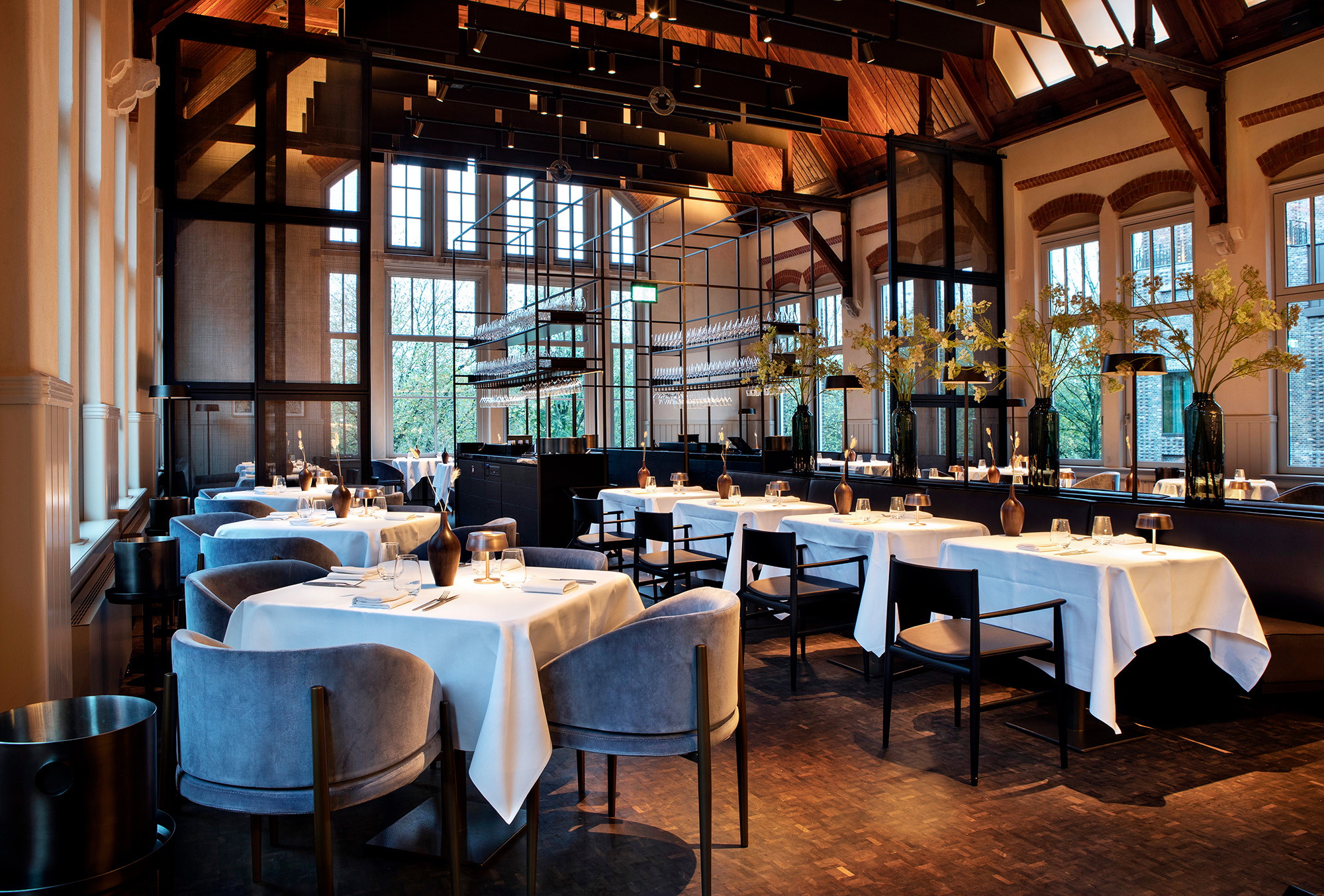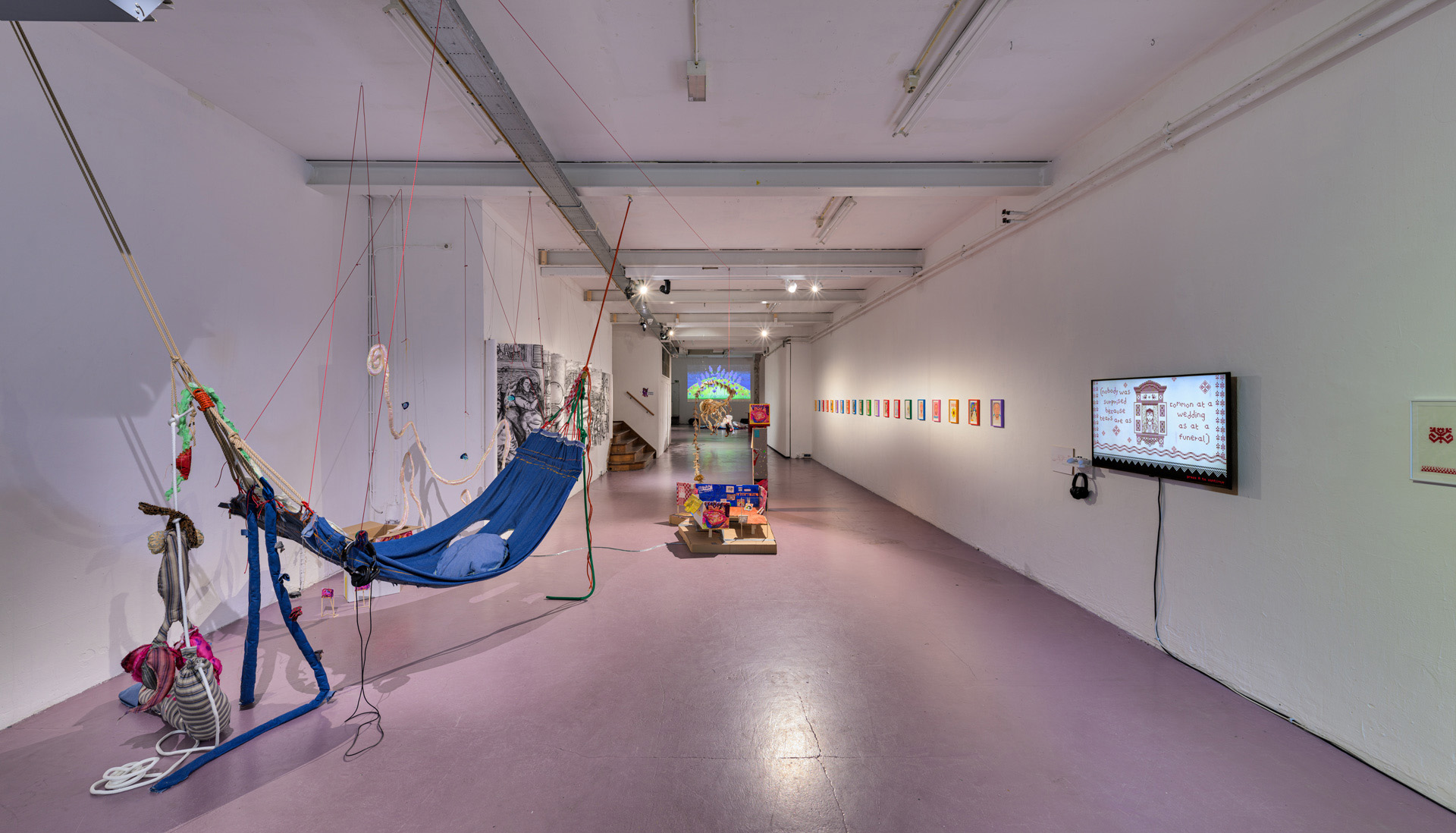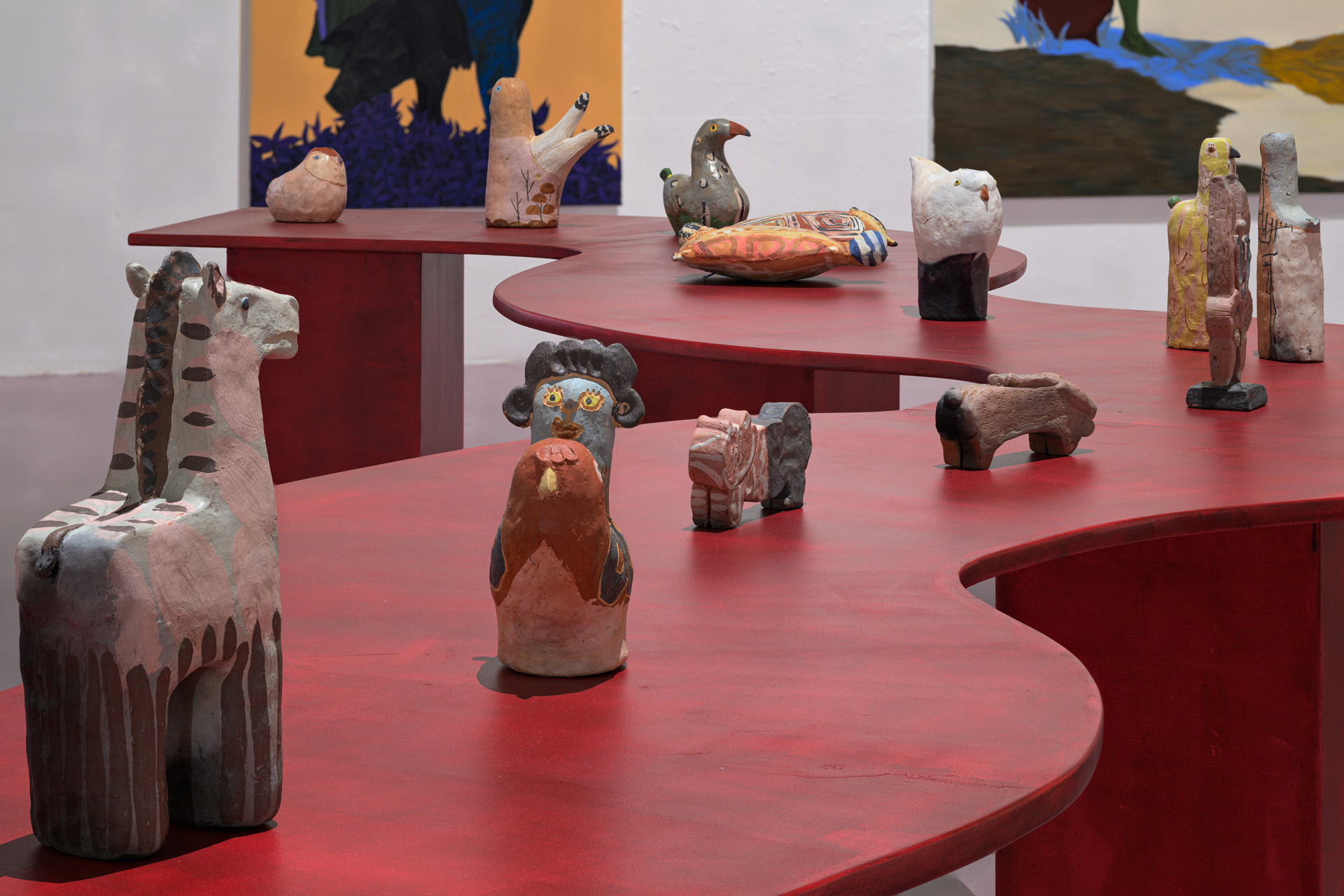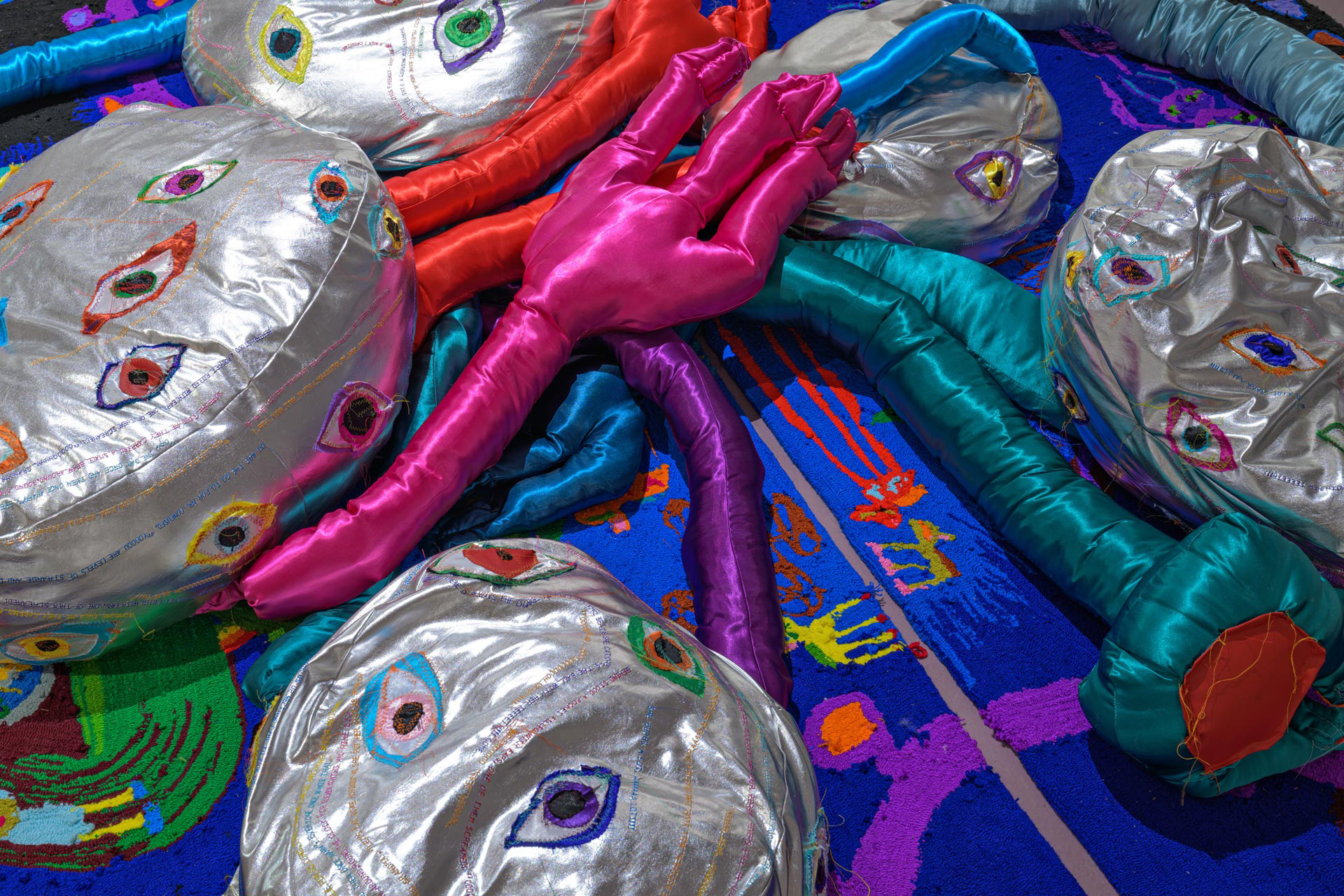A city soaked
in culture: Amsterdam Art Week 2024
Many cities have annual Art Week celebrations of their cultural side, but not in every city can a visitor travel between galleries & museums in a boat. As Veronica Simpson discovers, in Amsterdam you can. But there’s more than just the watery connections & canalside architecture, with countless emerging practitioners & established institutions to explore.
This year’s Amsterdam Art Week, the 12th edition of the annual event, featured over 200 artists and 70 locations. The host venues include galleries, project spaces, museums, residencies, and corporate collections. I travelled around the city, with a welcome stopover at the Pillows Grand Boutique hotel, to discover some highlights.
RIJSKAKADEMIE
We start our two-day delve into Amsterdam Art Week at the Rijksakademie – and it’s a suitable place to start the journey, considering it’s where much of the city’s cultural makers also start theirs. As one of the city’s enviable incubators for talent, offering fully funded, two-year residencies for local or global artists (something also offered at Amsterdam’s other leading residency institution, De Atelier) it is also the institution which co-initiated Amsterdam Art Weekend, along with a bunch of students and a few gallery owners. Now in its 12th edition, Amsterdam Art Weekend has since expanded to become Amsterdam Art Week [AAW] with 35 participating galleries, eight museums, 17 largely artist-run project spaces), and three other residency spaces.
As an instigator, the Rijksakademie’s Open Studios is a core component of AWW. The artists get to reveal the fruits of their thinking in the spacious facilities of a 19th century former army cavalry base, the Kavallerie-Kazerne, retrofitted by architect Koen van Velsen in the 1990s to hold 50 studios and an enviable array of technical workshops. There are 47 full-time, two-year residents, but some studios are offered on shorter term as collaborative residency spaces. The community is picked for their diversity of origin, practice, and perspective, with a collaborative, experimental approach encouraged. It’s not surprising that the 23-24 annual places a year – half of which are reserved for Dutch artists – are highly sought after. Director Emily Pethick, former Director of London’s Showroom space, tells us that they have around 1,600 applicants each year, the handful of non-Dutch applicants coming from 120 different countries.
We start our two-day delve into Amsterdam Art Week at the Rijksakademie – and it’s a suitable place to start the journey, considering it’s where much of the city’s cultural makers also start theirs. As one of the city’s enviable incubators for talent, offering fully funded, two-year residencies for local or global artists (something also offered at Amsterdam’s other leading residency institution, De Atelier) it is also the institution which co-initiated Amsterdam Art Weekend, along with a bunch of students and a few gallery owners. Now in its 12th edition, Amsterdam Art Weekend has since expanded to become Amsterdam Art Week [AAW] with 35 participating galleries, eight museums, 17 largely artist-run project spaces), and three other residency spaces.
As an instigator, the Rijksakademie’s Open Studios is a core component of AWW. The artists get to reveal the fruits of their thinking in the spacious facilities of a 19th century former army cavalry base, the Kavallerie-Kazerne, retrofitted by architect Koen van Velsen in the 1990s to hold 50 studios and an enviable array of technical workshops. There are 47 full-time, two-year residents, but some studios are offered on shorter term as collaborative residency spaces. The community is picked for their diversity of origin, practice, and perspective, with a collaborative, experimental approach encouraged. It’s not surprising that the 23-24 annual places a year – half of which are reserved for Dutch artists – are highly sought after. Director Emily Pethick, former Director of London’s Showroom space, tells us that they have around 1,600 applicants each year, the handful of non-Dutch applicants coming from 120 different countries.
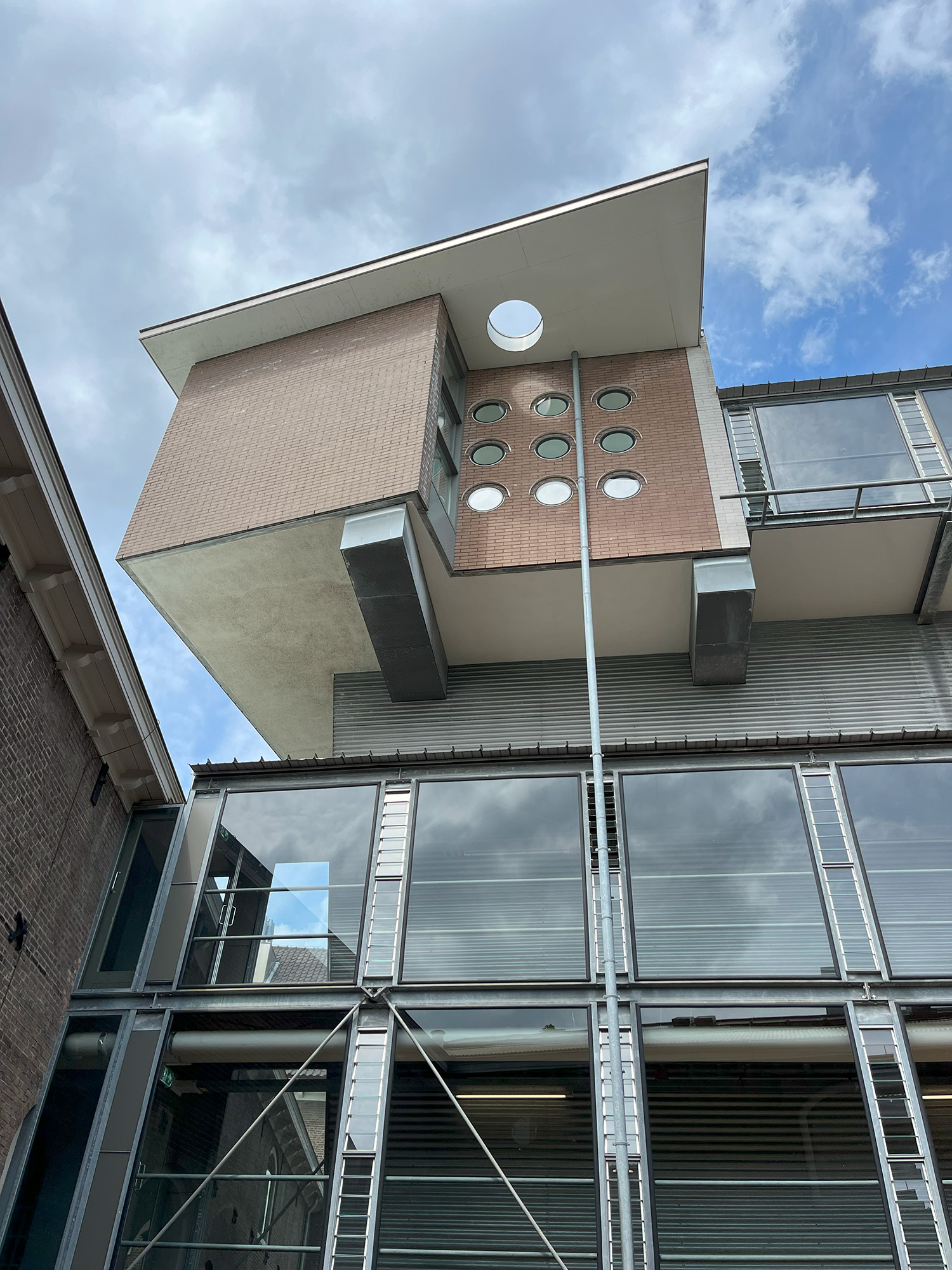

Rijksacademie photograph
© Veronica Simpson.
AAW week photograph courtesy of AAW.
www.rijksakademie.nl
︎ @rijksakademie




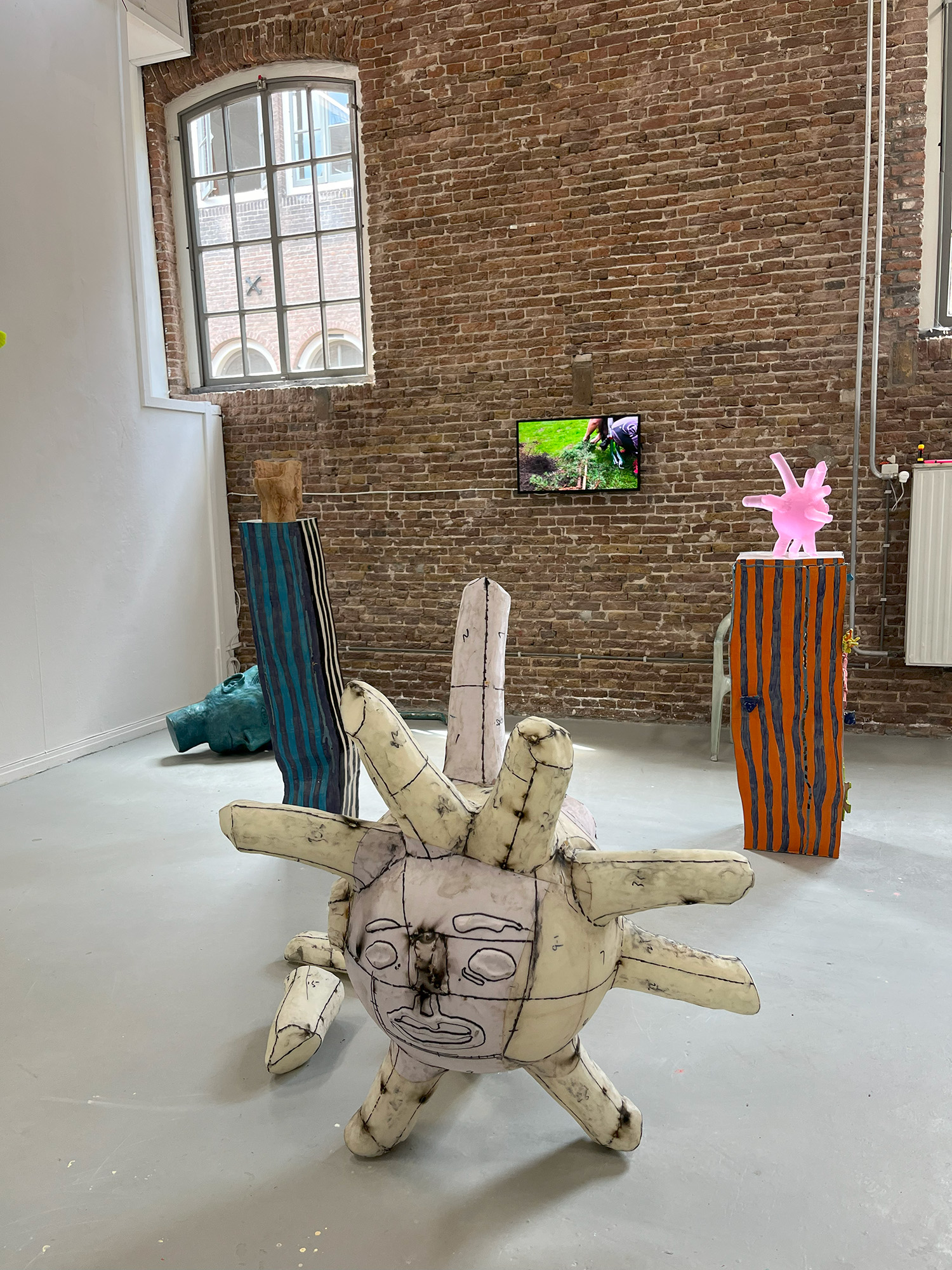
All photograhs
© Veronica Simpson.
Khalil Yusef
Vince Donders
︎
@vincedonders
Karel van Laere
︎ @karel_van_laere
We had a fascinating
look around the studios containing work with a wide range of themes, materials,
techniques and idea. “Remember, you are looking at process,” says Pethick, who
explains that the aim of the residency is to “help them evolve their own
language,” rather than emerge with a body of finished pieces.
A tiny snapshot includes: Karel van Laere’s Deep Tissue installation which combined the academy’s own plaster sculptures adorned with the artist’s delicate, aluminium body parts, as well as silvery writing protruding from wall works, taken from their own diary of touch inspired by Covid isolation. Vince Donders’ work explored erosion, corrosion, and decay with collapsing sculptures and wall pieces tinted in colours of rust, earth, Verdigris, and chartreuse – it was aptly titled Zeitgeist. Nearby, Susanne Khalil Yusef offered explosive and colourful works from graffiti’d walls through a neon sign spelling out “We Want to Live” in Arabic, to fleshy, pink landmines, articulating her horror at the ongoing violence in Gaza.
A tiny snapshot includes: Karel van Laere’s Deep Tissue installation which combined the academy’s own plaster sculptures adorned with the artist’s delicate, aluminium body parts, as well as silvery writing protruding from wall works, taken from their own diary of touch inspired by Covid isolation. Vince Donders’ work explored erosion, corrosion, and decay with collapsing sculptures and wall pieces tinted in colours of rust, earth, Verdigris, and chartreuse – it was aptly titled Zeitgeist. Nearby, Susanne Khalil Yusef offered explosive and colourful works from graffiti’d walls through a neon sign spelling out “We Want to Live” in Arabic, to fleshy, pink landmines, articulating her horror at the ongoing violence in Gaza.
ANNET GELINK GALLERY
Each studio offered something interesting, the fertile fermentations of two years of uninterrupted exploration. But it was clear that many showing are already market ready artists, with a freshness which must be catnip to the discerning collector or gallerist. And, sure enough, one of the city’s most established gallerists, Annet Gelink, talks with pride of having “discovered” Ryan Gander while he was studying at the Rijksakademie.
For AAW, Gelink is showing Josse Pyl in her eponymous gallery. Only four years out of the Rijksakademie hothouse themselves, the former typographer is also simultaneously showing at Stedelijk Museum Schiedam as one of the Netherlands’ five most promising artists under 35 in the Volkskrant Visual Arts Prize, the Dutch equivalent of the Turner Prize. Gelink can certainly pick them – though I remained intrigued more than charmed by Pyl’s deliberately distressed fragments of stone, plaster, and concrete, sometimes embedded with teeth
Each studio offered something interesting, the fertile fermentations of two years of uninterrupted exploration. But it was clear that many showing are already market ready artists, with a freshness which must be catnip to the discerning collector or gallerist. And, sure enough, one of the city’s most established gallerists, Annet Gelink, talks with pride of having “discovered” Ryan Gander while he was studying at the Rijksakademie.
For AAW, Gelink is showing Josse Pyl in her eponymous gallery. Only four years out of the Rijksakademie hothouse themselves, the former typographer is also simultaneously showing at Stedelijk Museum Schiedam as one of the Netherlands’ five most promising artists under 35 in the Volkskrant Visual Arts Prize, the Dutch equivalent of the Turner Prize. Gelink can certainly pick them – though I remained intrigued more than charmed by Pyl’s deliberately distressed fragments of stone, plaster, and concrete, sometimes embedded with teeth


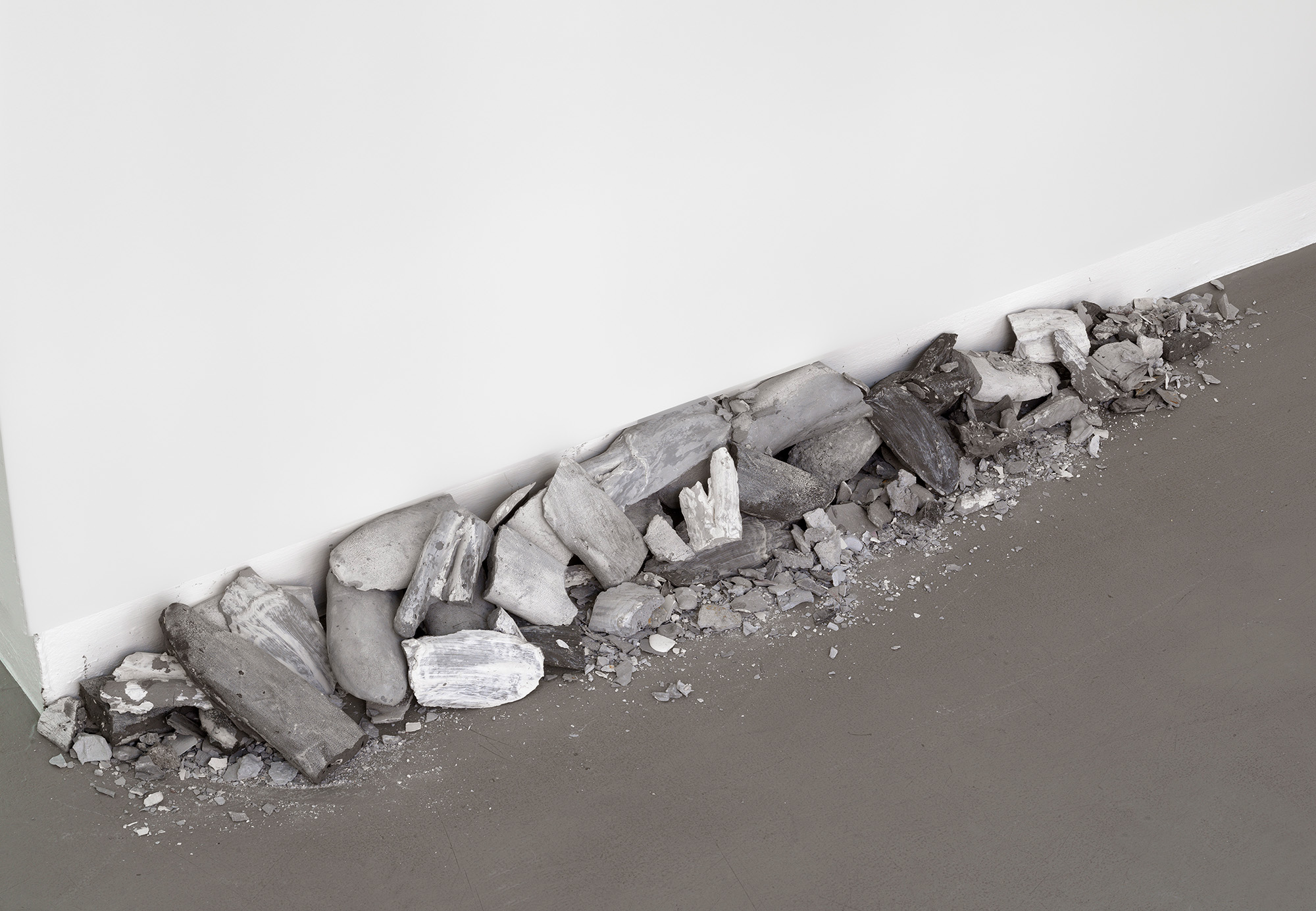
Photographs ©
Gert Jan van
Rooij. Courtesy of Annet Gelink Gallery.
Annet Gelink Gallery
︎ @annetgelinkgallery
Josse Pyl
︎ @jossepyl
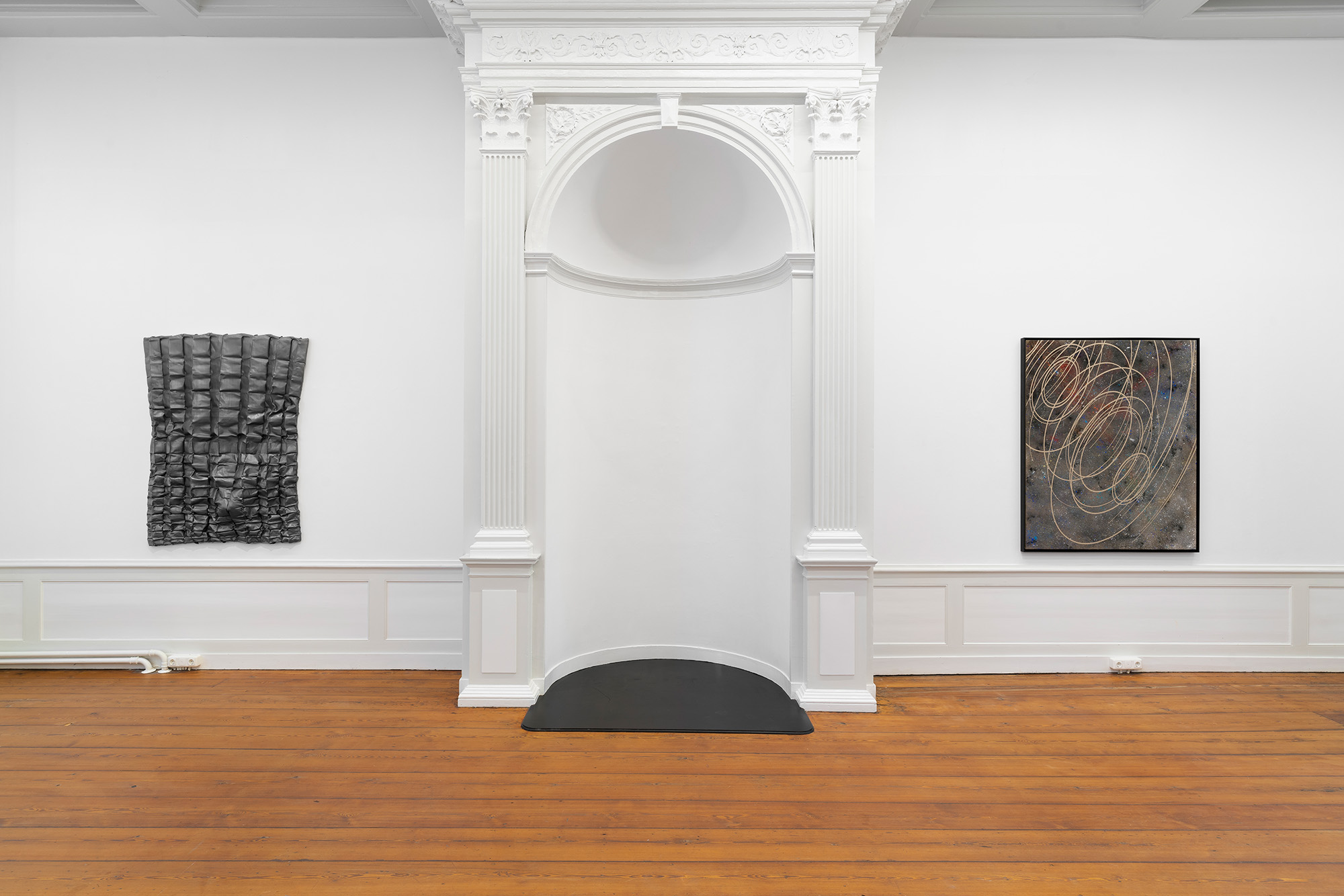


Photographs of
Guardians
by Frank Ammerlaan
©
Gunnar Meier, courtesy of
Upstream Gallery
Upstream
︎ @upstreamgallery
Frank Ammerlaan
︎ @frank_ammerlaan
UPSTREAM GALLERY
As with Art Weeks in many other cities, the point of AAW is to entice both hardcore and casual art lovers along with a wider audience of aesthetically curious, encouraging the latter to overcome their threshold anxiety and enter the luxurious once-private-houses turned galleries. One of the most beautiful of these 17th century canal-fronting houses is now Upstream gallery. Built in 1672 by Golden Age starchitect Philips Vingboons, with interiors cleanly but minimally restored, the timber floors and doors articulating many centuries of use. The leather chairs in one room were, quite frankly, knackered and the mantelpiece dusty, an informal, casual approach to decor that I warmed to, and so very different from London’s Mayfair.
The gallery director Nieck de Bruijn told us that the house belongs to a foundation for homeless people, who on the lower ground floor offer a space to eat, relax, stay dry and warm during the day, and launder clothes. Upstream occupies the upper ground floor, with higher floors occupied by lawyers devoted to social justice. I liked the calm and humble way he told this story, though he admitted it was an “unusual model, even for Amsterdam.”
Upstream’s main AAW showcase artist was Frank Ammerlaan, whose intriguing practice includes deceptively simple, framed geometric textiles formed of stretched fabrics often coloured with mud or meteor dust, alongside intriguingly animated, half-melted sculptures made with lead tiles.
As with Art Weeks in many other cities, the point of AAW is to entice both hardcore and casual art lovers along with a wider audience of aesthetically curious, encouraging the latter to overcome their threshold anxiety and enter the luxurious once-private-houses turned galleries. One of the most beautiful of these 17th century canal-fronting houses is now Upstream gallery. Built in 1672 by Golden Age starchitect Philips Vingboons, with interiors cleanly but minimally restored, the timber floors and doors articulating many centuries of use. The leather chairs in one room were, quite frankly, knackered and the mantelpiece dusty, an informal, casual approach to decor that I warmed to, and so very different from London’s Mayfair.
The gallery director Nieck de Bruijn told us that the house belongs to a foundation for homeless people, who on the lower ground floor offer a space to eat, relax, stay dry and warm during the day, and launder clothes. Upstream occupies the upper ground floor, with higher floors occupied by lawyers devoted to social justice. I liked the calm and humble way he told this story, though he admitted it was an “unusual model, even for Amsterdam.”
Upstream’s main AAW showcase artist was Frank Ammerlaan, whose intriguing practice includes deceptively simple, framed geometric textiles formed of stretched fabrics often coloured with mud or meteor dust, alongside intriguingly animated, half-melted sculptures made with lead tiles.
GRIMM
Another elegant canal-facing house gallery is home to GRIMM, a well-established commercial gallery which now has outposts in London and New York. For AWW, Grimm was showcasing one of its star artists, former Turner-prize shortlisted artist Michael Raedecker. He first trained in fashion and worked in couture before switching to painting – with a mid-90s residency at the Rijksakademie, followed by an MA at Goldsmiths College.
He uses several fascinating photography and printing techniques to create layered, absorbing works. This presentation of his most recent pieces showed his usual dystopian landscapes – abandoned cars and empty woodland cottages – with a sense of nature taking over, all enhanced with lavish embroidery. Coinciding with GRIMM’s AAW show, Raedecker is also enjoying the spotlight with a retrospective at the Kunstmuseum Den Haag, running until end of June.
Another elegant canal-facing house gallery is home to GRIMM, a well-established commercial gallery which now has outposts in London and New York. For AWW, Grimm was showcasing one of its star artists, former Turner-prize shortlisted artist Michael Raedecker. He first trained in fashion and worked in couture before switching to painting – with a mid-90s residency at the Rijksakademie, followed by an MA at Goldsmiths College.
He uses several fascinating photography and printing techniques to create layered, absorbing works. This presentation of his most recent pieces showed his usual dystopian landscapes – abandoned cars and empty woodland cottages – with a sense of nature taking over, all enhanced with lavish embroidery. Coinciding with GRIMM’s AAW show, Raedecker is also enjoying the spotlight with a retrospective at the Kunstmuseum Den Haag, running until end of June.



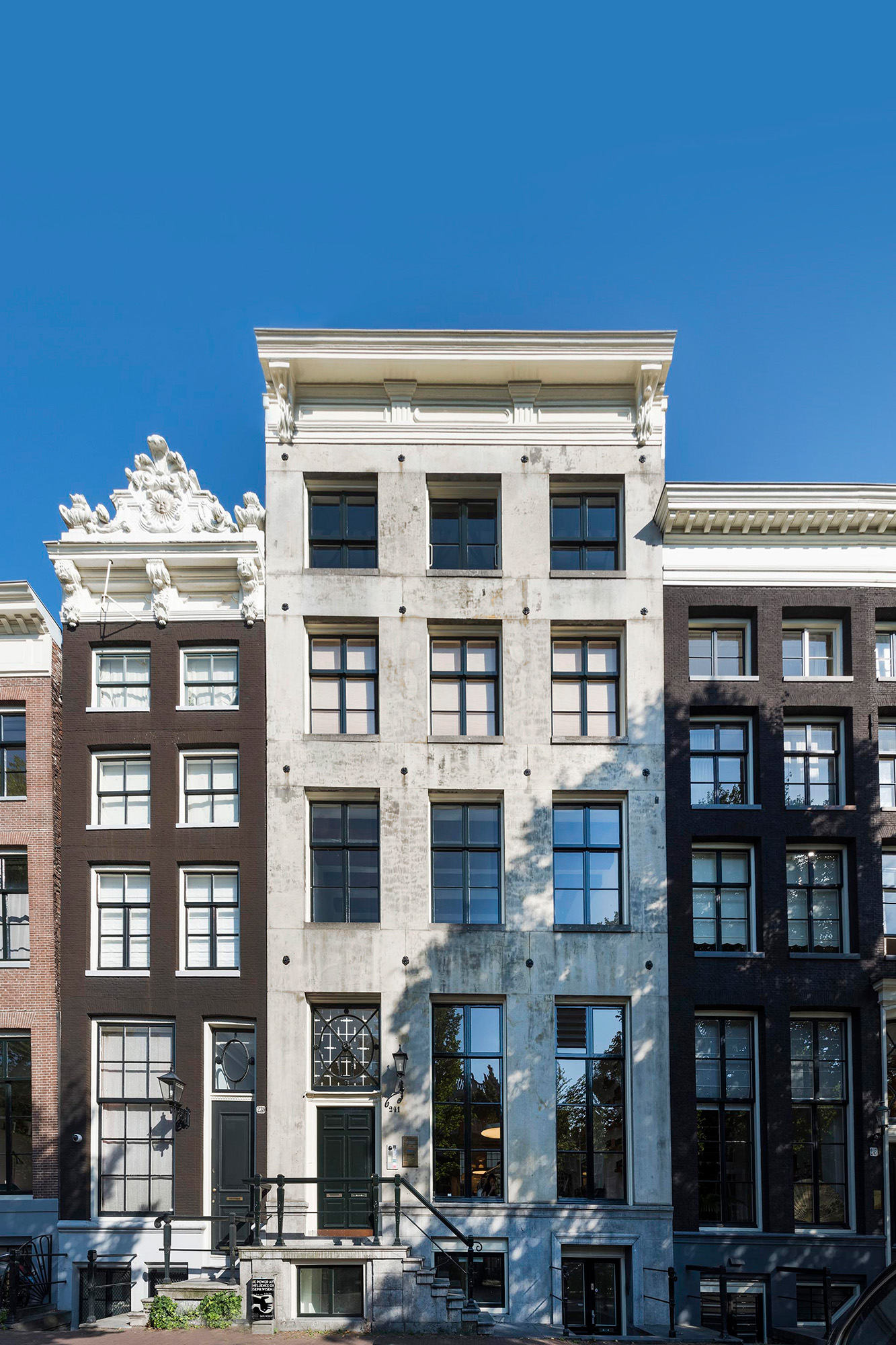
Photographs © Jonathan de Waart
GRIMM gallery
︎
@grimmgallery
Michael Raedecker
︎ @michaelraedecker
CULTUUR FERRY
There is evidently plenty of talent emanating from and resident within this city. You can understand why the museums and galleries are keen to leverage their position within the cultural tourism hierarchy – and to aid this they have recently launched a new boat tour, the Cultuur Ferry.
The boat takes visitors along the canals, stopping off at points along the way to allow exploration of the visual arts at each place. We only took a short trip, but it was enough to experience the mesmerising beauty of such lavish waterfront homes such as those occupied by GRIMM and Upstream, most of them built in Amsterdam’s 1575 – 1675 Golden Age, when Dutch advances in trade, arts, and science were the envy of the world.
There is evidently plenty of talent emanating from and resident within this city. You can understand why the museums and galleries are keen to leverage their position within the cultural tourism hierarchy – and to aid this they have recently launched a new boat tour, the Cultuur Ferry.
The boat takes visitors along the canals, stopping off at points along the way to allow exploration of the visual arts at each place. We only took a short trip, but it was enough to experience the mesmerising beauty of such lavish waterfront homes such as those occupied by GRIMM and Upstream, most of them built in Amsterdam’s 1575 – 1675 Golden Age, when Dutch advances in trade, arts, and science were the envy of the world.
THE INSTITUTIONS
Amsterdam is also a city full of international art institutions, and there was pretty enticing offer across these also. Marina Abramović was showing a version of her recent London Royal Academy retrospective at the Stejdelijk. There was a new exhibition exploring the 400-year-old relationship between Amsterdam and America at the Amsterdam Museum – Manahahtáanung or New Amsterdam? The Indigenous Story Behind New York – a collaborative exhibition with the Museum of the City of New York.
I also had time to catch the meditative Lee Ufan sculptures in the Rijksmuseum’s garden and a quick whizz around the museum’s Frans Hals’ exhibition, marvelling at his hyperreal ability to capture human life with oil paint. There was just enough time to visit a gallery space inside Oude Kerk, Amsterdam’s vast and barn-like oldest church. It took a while – this is a spectacular church with many architectural and historic distractions – but eventually I unearthed glass artist Ana Navas’ complex and sensuous work within her AAW show, A Veil as a Glaze.
Amsterdam is also a city full of international art institutions, and there was pretty enticing offer across these also. Marina Abramović was showing a version of her recent London Royal Academy retrospective at the Stejdelijk. There was a new exhibition exploring the 400-year-old relationship between Amsterdam and America at the Amsterdam Museum – Manahahtáanung or New Amsterdam? The Indigenous Story Behind New York – a collaborative exhibition with the Museum of the City of New York.
I also had time to catch the meditative Lee Ufan sculptures in the Rijksmuseum’s garden and a quick whizz around the museum’s Frans Hals’ exhibition, marvelling at his hyperreal ability to capture human life with oil paint. There was just enough time to visit a gallery space inside Oude Kerk, Amsterdam’s vast and barn-like oldest church. It took a while – this is a spectacular church with many architectural and historic distractions – but eventually I unearthed glass artist Ana Navas’ complex and sensuous work within her AAW show, A Veil as a Glaze.





Installation view, Marina Abramović, Stedelijk Museum Amsterdam, 2024. Photo © Peter Tijhuis Farm
Collectiecentrum Amsterdam Museum 30 oktober 2023. Photo
©
Francoise Bolechowski.
Lee Ufan photographs courtesy Rijksmuseum &
©
Albertine Dijkema.
Oude Kerk photograph
©
Em Kal Eyongakpa & Franz Mueller Schmidt.
Stedelijk Museum
︎ @Stedelijkmuseum
Amsterdam Museum
︎ @amsterdammuseum
Rijksmuseum
︎ @Rijksmuseum
Oude Kerk
︎ @OudeKerkamsterdam
PILLOWS GRAND BOUTIQUE HOTEL MAURITS
Art saturates Amsterdam. Even the owner of our luxurious, five-star hotel, Pillows Grand Boutique Hotel Maurits at Oosterpark, has his own art collection. We received a tour of it as part of our AAW visit. There are a few good Karel Appel monochrome prints in the ground floor bar, and some nice works in the corridor. For me, however, the hotel itself is the most fascinating work of art: a monolithic brick former university dissection laboratory designed by Jan Bernard Springer and built in 1908, it was elegantly and painstakingly refurbished and repurposed in 2022 by Office Winhov, celebrating the qualities and craftsmanship of the original: high ceilings, flesh-toned ceramic wall tiles, and bespoke stained-glass windows evoking medical lab equipment.
Our guide, the owner’s personal art consultant, promised us a Picasso at the start of the tour and saved it until last. In the low-slung and sexy downstairs bar there was a print of Dora Maar, bawling her eyes out – perhaps made miserable by his philandering ways. Staring at the blue tears spurting from her mis-aligned eyes got me thinking:
What kind of man wants to paint his lover brutalised by his own behaviour? Followed by a question: And what kind art collector would want this in their collection?
Art saturates Amsterdam. Even the owner of our luxurious, five-star hotel, Pillows Grand Boutique Hotel Maurits at Oosterpark, has his own art collection. We received a tour of it as part of our AAW visit. There are a few good Karel Appel monochrome prints in the ground floor bar, and some nice works in the corridor. For me, however, the hotel itself is the most fascinating work of art: a monolithic brick former university dissection laboratory designed by Jan Bernard Springer and built in 1908, it was elegantly and painstakingly refurbished and repurposed in 2022 by Office Winhov, celebrating the qualities and craftsmanship of the original: high ceilings, flesh-toned ceramic wall tiles, and bespoke stained-glass windows evoking medical lab equipment.
Our guide, the owner’s personal art consultant, promised us a Picasso at the start of the tour and saved it until last. In the low-slung and sexy downstairs bar there was a print of Dora Maar, bawling her eyes out – perhaps made miserable by his philandering ways. Staring at the blue tears spurting from her mis-aligned eyes got me thinking:
What kind of man wants to paint his lover brutalised by his own behaviour? Followed by a question: And what kind art collector would want this in their collection?
W139
The most exciting, eclectic, and exuberant art was that made by artists for themselves, as witnessed at the Rijksmuseum and also one of the city’s longest standing studio and project spaces, W139 – one of the first squatted spaces of artistic liberation in the city centre. We were shown around their new exhibition Outside The Soup, gestated over three years by artists Afra Eisma and Hend Samir. Eisma explains how the show evolved: “We felt that sometimes when you see your work together with another artist’s, they become kind of friends, and if your work fits then often you also fit together with the other person. We wanted this show not to have a structural theme, but to evolve from the spirits of the art works and the makers behind them.”
She’s not wrong. There really are many more layers of connection between the works than is typical in a group presentation. Making full use of the depth and height of this former industrial building, a gloriously spectral skeletal structure lured us along the narrow first gallery into the vast one to the rear. The Blue Wadi by Esraa Elfeky is a possibly real, possibly mythical, desert creature, whose story is also outlined in a luminous adjacent illustration. There were innumerable absorbing narratives – as well as unlikely materials, including waste plastic – woven into Italian artist Marzia Migliore’s 10m textile, whose monochrome sobriety offset the glowing, earthy (and unearthly) tones of an adjacent slightly longer draped textile work by Dagmar Bosma printed with rusting machine parts and mud.
The most exciting, eclectic, and exuberant art was that made by artists for themselves, as witnessed at the Rijksmuseum and also one of the city’s longest standing studio and project spaces, W139 – one of the first squatted spaces of artistic liberation in the city centre. We were shown around their new exhibition Outside The Soup, gestated over three years by artists Afra Eisma and Hend Samir. Eisma explains how the show evolved: “We felt that sometimes when you see your work together with another artist’s, they become kind of friends, and if your work fits then often you also fit together with the other person. We wanted this show not to have a structural theme, but to evolve from the spirits of the art works and the makers behind them.”
She’s not wrong. There really are many more layers of connection between the works than is typical in a group presentation. Making full use of the depth and height of this former industrial building, a gloriously spectral skeletal structure lured us along the narrow first gallery into the vast one to the rear. The Blue Wadi by Esraa Elfeky is a possibly real, possibly mythical, desert creature, whose story is also outlined in a luminous adjacent illustration. There were innumerable absorbing narratives – as well as unlikely materials, including waste plastic – woven into Italian artist Marzia Migliore’s 10m textile, whose monochrome sobriety offset the glowing, earthy (and unearthly) tones of an adjacent slightly longer draped textile work by Dagmar Bosma printed with rusting machine parts and mud.




Photographs © Pieter Kers
W139
︎ @w139amsterdam
Afra Marciel
︎ @aframarciel
Esra Elfeky
︎ @elfekyesraa
Marzia Migloria
︎ @marziamigliora
Dagmar Bosma
︎ @tuff_n_tender
Along a
curving plinth marched the vivid characters of Hiroki Miura’s brittle yet
weirdly cuddly ceramics. Beyond that, we were invited, by its gentle colours,
mellow soundtrack and meditative pace to sit and watch a tender and thoughtful
animation by Marnix van Uum – and made welcome in this corner by Afra Eisma’s
effervescent, embroidered textile bean-bags – whose sweet and vulnerable
portraits also illuminated her reflections on mental health by the door. In my
view, it fully earned the playful, papier-maché Golden Lion statuette they had
awarded themselves, at the door.
Annette Wolfsberger, one of the managers of the space, struck a note of warning regarding changes in Amsterdam’s artist ecology: she said that they were only there by the grace of the foundation that owns the building. “All the art spaces, especially the non-profit ones in the city centre,” she esplains, “have disappeared because the funding pressure is high, rents are up.”
Annette Wolfsberger, one of the managers of the space, struck a note of warning regarding changes in Amsterdam’s artist ecology: she said that they were only there by the grace of the foundation that owns the building. “All the art spaces, especially the non-profit ones in the city centre,” she esplains, “have disappeared because the funding pressure is high, rents are up.”
A sobering
thought to leave on: this is clearly a city that is – or has been – a good
place to be an artist. But the balance has shifted, and will shift further as
state funding dwindles and tourism continues to push city centre rents up and
artists out.
Is chasing more sharp-eyed collectors and global gallery owners, or boosting cultural tourism, the answer to rebalancing Amsterdam’s delicate ecosystem? We could follow the money: but that’s not usually the route to a richer, more diverse, and equitable environment which allows ideas and creatives to flourish.
Is chasing more sharp-eyed collectors and global gallery owners, or boosting cultural tourism, the answer to rebalancing Amsterdam’s delicate ecosystem? We could follow the money: but that’s not usually the route to a richer, more diverse, and equitable environment which allows ideas and creatives to flourish.
Stichting Amsterdam Art promotes and connects Amsterdam's contemporary
art institutions and artists to
strengthen the city's artistic ecosystem and make it accessible to local and
international audiences.
Since 2011, Amsterdam Art Week strengthens and transforms the city into
a meeting hub for (inter)national
artists, art lovers, professionals and collectors. Amsterdam Art Week
fosters collaborations, special
programming and events and activates an overarching network of visitors and art professionals.
Year round Amsterdam Art is a leading platform, promoting the current
offerings of Amsterdam’s contemporary art
institutions.
www.amsterdamart.com
Veronica Simpson has spent the last three decades observing the most interesting evolutions in design, architecture & art, for both consumer & specialist magazines, including Sunday Times Style, Blueprint, Damn and Studio International. Informed by an MSc in Environmental Psychology (2009-10, University of Surrey), her writing aims to place these creative disciplines in context as they relate to human needs or changing social & cultural values. With the current planetary & economic crises in mind, her writings prioritise the artists, designers & architects whose work best articulates the critical issues & ideally offers enlightened responses.
www.amsterdamart.com
Veronica Simpson has spent the last three decades observing the most interesting evolutions in design, architecture & art, for both consumer & specialist magazines, including Sunday Times Style, Blueprint, Damn and Studio International. Informed by an MSc in Environmental Psychology (2009-10, University of Surrey), her writing aims to place these creative disciplines in context as they relate to human needs or changing social & cultural values. With the current planetary & economic crises in mind, her writings prioritise the artists, designers & architects whose work best articulates the critical issues & ideally offers enlightened responses.
visit
Amsterdam Art Week is due to return in 2025, but all the participating institutions & organisations have year-long programmes. For more information on culture in Amsterdam visit:
www.amsterdamart.com
publication date
17 June 2024
tags
Marina Abramović, Frank Ammerlaan, Amsterdam, Amsterdam Art Week, Amsterdam Museum, de Atelier, Karel Appel, Jan Bernard Springer, Dagmar Bosma, Nieck de Bruijn, Cultuur Ferry, Vince Donders, Afra Eisma, Esraa Elfeky, Ryan Gander, Annet Gelink Gallery, GRIMM, Frans Hals, Susanne Khalil Yusef, Dora Maar, Marzia Migliore, Hiroki Miura, Museum of the City of New York, Ana Navas, Office Winhov, Oude Kerk, Emily Pethick, Picasso, Pillows Grand Boutique Hotel Maurits at Oosterpark, Josse Pyl, Michael Raedecker, Rijksakademie, Hend Samir, Veronica Simpson, Stejdelijk, Stedelijk Museum Schiedam, Lee Ufan, Upstream, Karel van Laere, Marnix van Uum, Koen van Velsen, Philips Vingboons, Annette Wolfsberger, Volkskrant Visual Arts Prize, W139
www.amsterdamart.com
publication date
17 June 2024
tags
Marina Abramović, Frank Ammerlaan, Amsterdam, Amsterdam Art Week, Amsterdam Museum, de Atelier, Karel Appel, Jan Bernard Springer, Dagmar Bosma, Nieck de Bruijn, Cultuur Ferry, Vince Donders, Afra Eisma, Esraa Elfeky, Ryan Gander, Annet Gelink Gallery, GRIMM, Frans Hals, Susanne Khalil Yusef, Dora Maar, Marzia Migliore, Hiroki Miura, Museum of the City of New York, Ana Navas, Office Winhov, Oude Kerk, Emily Pethick, Picasso, Pillows Grand Boutique Hotel Maurits at Oosterpark, Josse Pyl, Michael Raedecker, Rijksakademie, Hend Samir, Veronica Simpson, Stejdelijk, Stedelijk Museum Schiedam, Lee Ufan, Upstream, Karel van Laere, Marnix van Uum, Koen van Velsen, Philips Vingboons, Annette Wolfsberger, Volkskrant Visual Arts Prize, W139


